Hidden in this garage is a promising project. It is an essentially solid 1952 Hudson Hornet Club Coupe. Although it needs work, the included second car should supply many parts required to return it to its former glory. It could represent a rewarding family project, with the whole tribe set to benefit from the finished product. The Hudson is listed here on eBay in Portland, Oregon. It has attracted a solitary bid of $12,000 in a No Reserve auction.
Hudson introduced its First Generation Hornet in 1951, utilizing the company’s “step-down” design philosophy unveiled with the 1948 Commodore. By recessing the floors between the frame rails, it lowered the car’s center of gravity and provided a lower and sleeker appearance than its competitors. The history of this car is unclear, but it is an essentially complete vehicle with only minor rust issues. There is a small (and typical) area in the spare wheel well and a spot below the rear seat. The seller admits there are other minor pinholes in the panels, but nothing justifying wholesale replacement. There is rust in one frame rail, but it is limited to an area approximately 2″ long and should be a straightforward repair. A previous owner performed Bondo repairs, but locating them is easy because the Bondo has begun to fall out! A few small pieces are missing, but the included 1952 Commodore 8 parts car should supply most of what is required to complete this build.
While competitors turned their attention to V8 power, Hudson slotted its 308ci flathead “Twin H-Power” straight-six under the hood of the ’52 Hornet. It may have had fewer cylinders than some of the competition, but with 145hp on tap, the Hornet offered excellent performance. The seller indicates this car’s engine and transmission are from a ’52 sedan, but they pose a mystery. The transmission is unknown because the vehicle doesn’t feature the clutch pedal for a manual nor a shifter quadrant to confirm it is an automatic. The seller seems approachable, meaning they may be happy to answer questions on the matter. The parts car houses an extra six and automatic transmission, making it a ready source of mechanical spares. The Hudson doesn’t run or drive, requiring work before it roars into life. However, the suggestions are this shouldn’t be difficult. That could allow the new owner to tackle the rewarding tasks in a home workshop.
As with the rest of the car, the Hudsn’s interior is complete but needs love. The front seat wears an aftermarket cover, while the original on the back seat is pretty shredded. Some upholstered surfaces may respond to a deep clean, but the new owner should probably brace for a complete retrim. It won’t be cheap, but with the correct materials available “off the roll” from several suppliers, a faithful restoration is there for the taking.
A new group of potential classic car enthusiasts has become aware of the First Generation Hudson Hornet courtesy of the “Cars” movie franchise. That may motivate a parent to encourage their children to engage in this restoration. Even if it doesn’t, rapidly climbing values could make it a worthwhile project for the right person. The parts car is a bonus and offers another alternative worth considering. The new owner could remove the parts they require and relist it for sale. That would allow them to recoup a percentage of their purchase price, adding valuable cash to the restoration budget. Would you do that, or would owning a pair of Hudsons be irresistible?
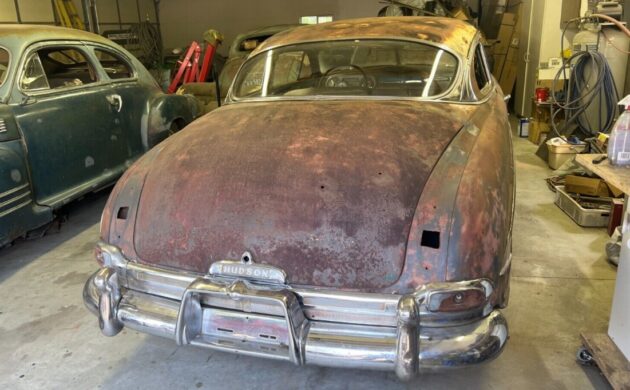
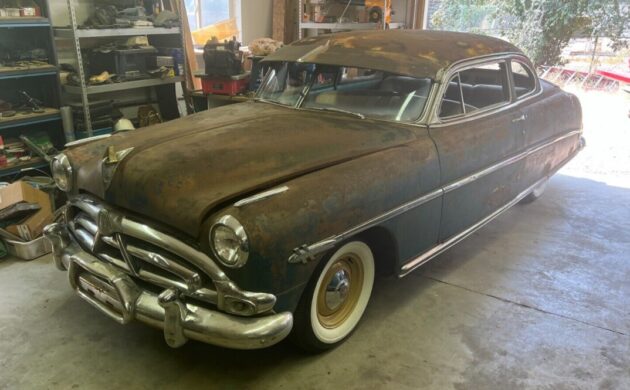
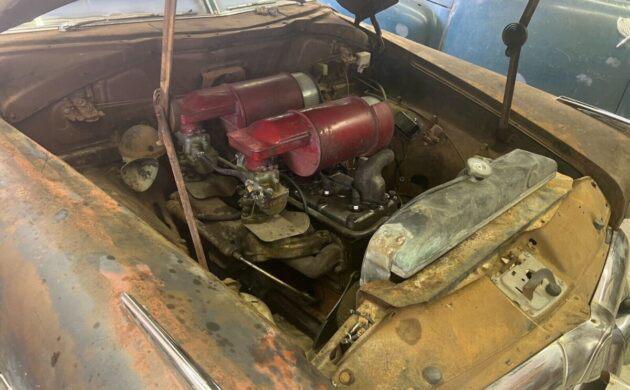
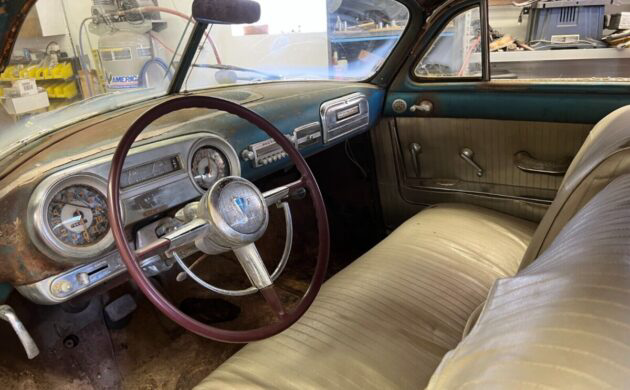
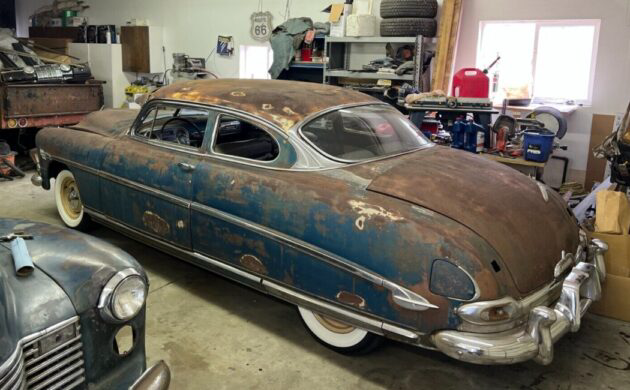

The late, very great Dick Mann was a Hudson enthusiast and would talk with the owners at local car shows around here and Central Northern California. He suffered no fools but would talk at length with those who’d brought one o a show, especially if they’d driven it there! He knew his stuff and enjoyed those, as he did with the bike show/swap meets he’d suddenly appear at especially in San Jose at the fairgrounds..
He, like the bikes and cars he enjoyed, were an iconic moment in history that we will never see again.
I hope the new seller restores this (perhaps both?) as faithfully as possible and enjoys them for what they are for years to come.
This was my first car in 1967. At that time 57 Chevrolets were the hot thing. Only problem with this car was not a girl in my high school would be seen in it. This baby was a pig off the line, but after rolling for a mile or so, could pass anything else on the freeway.
Neat car . Hope the pair find a good hope whether restomod or stock.glwts.
One that has always been on my list, long before cars and other things brought these to light. Otherside of the moon from me plus I have long termed that will be finished this year. So no more right now.
Could someone please explain how those air cleaners work?
It looks like there is a conventioal circular paper element on top of a big red can, that reduces to a duct to the top of the carburetor.
What does the can do?
LCL, I’d be happy to explain. The twin H air cleaners for these cars were made by AC Spark Plug in Flint, MI to Hudson specs. They were designed much like the Buick air cleaners . They had quick change filters on the non manifold side to avoid getting in the way of linkage and heat. There was also an oil filled version of the Twin H as well. They also could proudly display the ‘Twin H Power ‘ decal on the long canister filters as well. Trust me when you open your hood at a car show with these no one will leave you alone.
Thank for the detail. I appreciate it. LCL
Lance & LCL,
Those long canisters also served another purpose, usually found on the more expensive American cars; those wide chambers allowed the air to slow down [like a reverse venturi effect], and made the air movement quieter.
Post war cars were getting longer and lower, and one of the problems that came with a lowered hood line was the lack of room for the big oil bath air cleaners, so manufacturers began putting them off to the side, requiring long air ducts from the filter to the top of the carb. Those long tubes resulted in more air flow noise.
I’m sure many of us are well aware of the whooshing sound air makes as it heads through the air filter assembly. That sound means there is Disturbed airflow between the filter and the carb opening. In the 1950s American luxury automobile manufacturers wanted to make their cars as quiet as possible, and these air cleaner chambers helped.
For example, for the 1948-50 Packards, the cheaper Standard 8 had a basic oil bath air cleaner on top of the carb. The mid-line Super 8 had a small added chamber like on this Hudson, and the big top-of-the-line Custom Eight had a larger chamber. About 30 years ago I had a 1950 Custom Eight sedan with only 1,100 miles, and standing only a couple of feet from the front fender, it was almost impossible to hear that engine running at idle.
Nothing against this car but I’d rather have the Series 61 next to it…
This one reminds me of a Mercury
My father worked at the Jefferson Avenue Chrysler plant. Hudson was only a few blocks and the other side of Jefferson Ave. When Hudson manufactured the 1954 models the yard was was then very beautiful with all the Hudsons in the new bright colors that were introduced. My dad would take every year when Chrysler had their open house. I would be able to see all the cars on the assembly line..
My first car was 52 Hudson.
Beautiful lines on this Hudson. Also, interesting dual single carbs and cleaners on the 6 cylinder. I’m sure most people at a car show wouldn’t leave you alone once you opened its hood. Great find.
I remember in 1958 I could have bought a 1952 Hudson Hornet convet. for $800.00. Was yellow with a blacktop and had power windows. Next to it was a 1948 Lincoln 4 door, V 12 , color was green, price $700.00.
“Solitary bid of $12,000 in a no reserve auction . . .,” well, now we know what the reserve really is!
Dont know much about these cars but they look heavy and big I’m thinking that they ride nice ,,like a Packard and lotsa room inside,,I wouldnt mind having one but another person disagrees with that,,Parents bought a 55 hudson Hornet and when I saw it the next morning in the garage I was a very disapointed kid,But it was a nice car just didnt look hot
I have a 51 Hornet Hollywood and they do ride extremely well. They are not as heavy as you think. My Hudson is only about 540 lbs (about 3 average sized adults) heavier than my C5 Corvette.
Adam,
This car is equipped with Hydramatic. Many years ago I had an almost identical Hudson Hornet Brougham [2-door] with Hydramatic.
It’s hard to see, but if you look at the photo of the dash and steering wheel, Just behind the steering wheel center you can see the Hydramatic shift quadrant, and the shift rod on top of the steering column. Also note that as it’s a GM Hydramatic, Park gear is located at the reverse location when the engine is not running, and in the same photo the shift lever is in the Park/Reverse location.
Some of the lesser-priced Hudsons did have a Hydramatic emblem on the trunk lid, but because cars like this one had [in addition to the “Hudson” emblem on the trunk lid handle] another emblem half-way up the trunk lid, on the right side. It was a rocket that said “Hornet”. If the car had Twin H Power, it bore another emblem spelling out that option too!
I suspect the Hudson designers felt that adding a 4th emblem would be too much!
My grandfather would’ve loved these.
He bought Hudson’s for most of his
life. His first new car was a ’35 Terraplane 4-door sedan, and his last
was a ’52 Hornet 4-door sedan. It broke his heart when he found out the
company was closing for good. And
to make matters worse, he really took
a bath when he traded it for a new ’58
Ford wagon which he kept for 2 years
before buying a ’60 Chevy wagon with
a 348/Powerglide in it. When he passed, he was the proud owner of a
’65 Buick Wildcat 4-door hardtop with
a 400/T400 in that. As for this pair,
I’d restore the H-Power car and resto
mid the parts car using a 205 HP Buick V-6 mated to a 700aR4 tranny.
Might just pump up the ponies by adding a turbocharger with 10 PSI of
boost. That way, I’d have the best of
both worlds– a restored car and a
real screamer I could use every day.
Now THAT’S how you do a BOGO!
Guys,,,,,, The truck lid is from a 40-50 Hunson with the small upper tail lights and you see where the holes are.
Please realize this is not the orginal lid and there is no chance the labels will match up